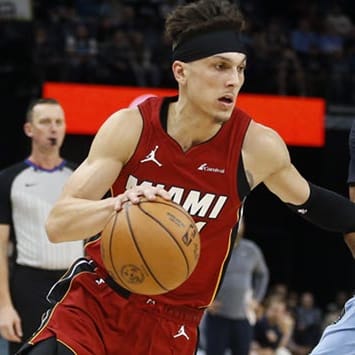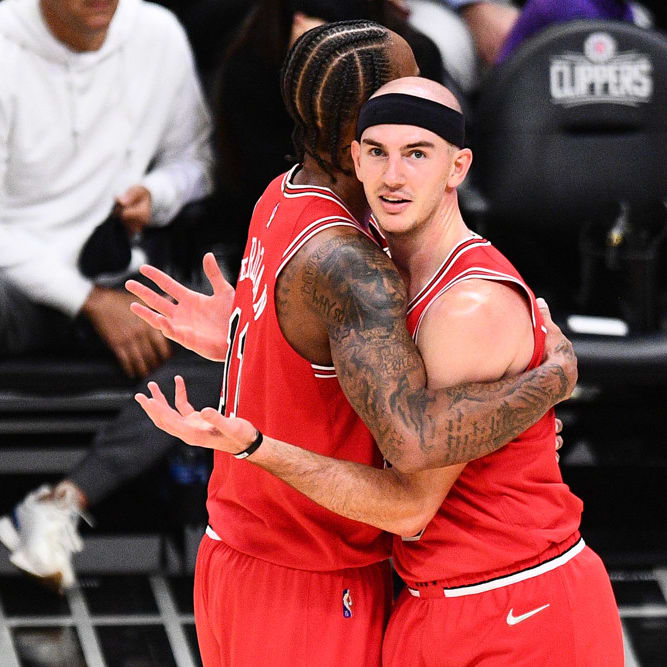This article is part of our Numbers Game series.
Then-NFL coach Dennis Green famously declared: "They are who we thought they were." After last week's trade deadline, I wonder, does his wisdom apply to traded players?
One of my favorite fantasy analysts argues that, fundamentally, a player is who he is. He claims that on a per-possession basis, players are more or less predictable. Sure, he says, young guys improve and old guys decline, roles and teams change, but the per-possession numbers remain relatively stable.
The NBA trade deadline gives us an opportunity to investigate this idea, and with immediate fantasy implications. When players changed teams midseason, regardless of their role, has their per-possession production remained stable?
What are we looking at and why do we care?
This idea – that a player "is who he is" on a per-possession basis – is most relevant before the draft or after a trade. Thirty-six players were traded in February, and a few more changed teams through the NBA's waivers system. Beyond that, traded players provide a rare statistical opportunity to study our basic assumption. I'll address those in reverse order.
Players traded midseason can be a statistical goldmine. The player is the same age and in roughly the same state of overall mental and physical health while playing for both teams. The player has not had an offseason to –- insert trite offseason storyline here (develop his three-point shot; gain 20 pounds of pure muscle; become vegan; host sleepovers for the point guard's children; become rusty, fat, old and
Then-NFL coach Dennis Green famously declared: "They are who we thought they were." After last week's trade deadline, I wonder, does his wisdom apply to traded players?
One of my favorite fantasy analysts argues that, fundamentally, a player is who he is. He claims that on a per-possession basis, players are more or less predictable. Sure, he says, young guys improve and old guys decline, roles and teams change, but the per-possession numbers remain relatively stable.
The NBA trade deadline gives us an opportunity to investigate this idea, and with immediate fantasy implications. When players changed teams midseason, regardless of their role, has their per-possession production remained stable?
What are we looking at and why do we care?
This idea – that a player "is who he is" on a per-possession basis – is most relevant before the draft or after a trade. Thirty-six players were traded in February, and a few more changed teams through the NBA's waivers system. Beyond that, traded players provide a rare statistical opportunity to study our basic assumption. I'll address those in reverse order.
Players traded midseason can be a statistical goldmine. The player is the same age and in roughly the same state of overall mental and physical health while playing for both teams. The player has not had an offseason to –- insert trite offseason storyline here (develop his three-point shot; gain 20 pounds of pure muscle; become vegan; host sleepovers for the point guard's children; become rusty, fat, old and decrepit; etc.). Traded players give us data samples on two different teams while the player is nearly unchanged. To put that more mathily – there is less noise degrading the reliability of the data.
Hopefully, data from traded players will show us that, yes, indeed, "they are who we thought they were." If that's the case, we can more accurately predict someone's production after a trade. The more accurately we can predict production, the greater our advantage in fantasy.
Diving in
During the 2015-16 season, 23 players were traded midseason and played at least 40 minutes for both teams. These players make up our data pool. We are looking at players' per-possession statistics only, to minimize the impact of a team's pace and the individual's role in the rotation.
To start, I did a basic check (correlation coefficient, which I explained here) on how strong the relationship was between a player's per-possession stats pre- and post-trade. This immediately yielded interesting results.
Surprising no one, the relationships were different from category to category. However, the size of those differences was a lot larger than I anticipated. The relationship in most scoring categories – points, field goal attempts, field-goal percentage and three-point percentage – were vanishingly small. In these categories, based on this initial test, players' per-possession data appeared completely meaningless, if not actively misleading. However, several others showed very strong relationships. Three-point attempts, turnovers and rebounds showed powerful relationships, and assists and offensive rebounds were almost ice-cream-sales-on-a-sunny-day level predictive.
Next, I ran the same check, but I increased the minutes minimum from 40 to 100. This eliminated three players whose small amount of court time may have inappropriately confused the data. Based on the results, this seems to have been a good decision. Almost all correlations improved, meaning that after eliminating those with only tiny amounts of court time, a players' pre-trade production was more predictive of their post-trade numbers. The same scoring categories remained astonishingly low, and points and three-point percentage actually got lower, to the point where they approached coin-flip level random. Due to these results, for the rest of this article, I will limit the research to the 20 players who hit the 100 minutes minimum.
Taken altogether, our early findings indicate that while there is some merit to the "they are who we thought they were" theory, there may be some critically significant flaws limiting its usefulness.
Looking at Each Skill, One at a Time
For my last set of tests, I zoomed in on each category. For example, when looking at rebounds, I might down-selected to include only the players who averaged at least 6.0 rebounds per 100 possessions before they were traded. The logic here is two fold. First, a fantasy team looking to add rebounding will only look to players with proven ability in that category. Second, it is possible that by focusing in on each individual skill, we will find stronger relationships. Depending on the results, this could indicate that our per-possession approach is actually very strong, but only if limited properly.
Points
Ruling: They are NOT who we thought they were.
No matter how I played with the data, I couldn't make points show a meaningful relationship. As far as I can tell, a player's per-possession scoring on one team is totally unrelated to their per-possession scoring on a different team. Most of the time, pre-trade per-possession stats were barely more predictive than picking numbers out of a hat – I'm not exaggerating.
The only time the data clearly beat hat-picking was when I limited by field-goal attempts per possession. The players who shoot frequently on one team are slightly more likely to shoot frequently on their new team. Further, looking only at frequent shooters, the amount of points they score on their first team has some relationship to their points scored on their second team. But here, too, the relationship is so low that it is perhaps best ignored.
Three-Pointers
Ruling: Shooters keep shooting, otherwise they are NOT who we thought they were.
Three-point shooting efficiency is not transferrable. No down-selection of the data gave a correlation that dramatically outperforms predicting a coin flip.
That said, there is a relatively strong relationship between three-point attempts from one team to the next. Players who attempt a lot of threes on one team are likely to continue to attempt a lot of threes on the next team. The relationship was even stronger in the other direction – players who attempt threes infrequently will probably continue attempting threes infrequently.
Rebounds
Ruling: They ARE who we thought they were.
From the beginning, this was one of the categories were our core assumption looked strongest. The more minutes players logged for each team, the stronger the relationship between their pre- and post-trade rebounding totals.
Notably, offensive rebounds are even more predictive than total rebounds. Throughout my research, no matter what the sorting criteria, offensive rebounds and assists had the strongest relationships. These two skills, more than any other I examined, seem to be transferrable from one team to the next.
Assists
Ruling: They DEFINITELY ARE who we thought they were.
As I just mentioned, assists showed the strongest relationships throughout this research. A player's ability to tally assists seems pretty independent of their team setting.
Super Interesting Side-discovery: High-volume assisters showed more predictive per-possession stats across the board. Focusing only on players who dished more than 3.0 assists per 100 possessions, the correlation coefficients improved for almost every category (excepting field goal attempts and turnovers). Even categories like blocks showed some of their strongest relationships once players who don't assist were eliminated from the data pool. Applying some basketball logic to this math stuff, the finding seems to be this: the more important passing is in a player's skill-set, the more similar his role will be from one team to the next, allowing most of his per-possession stats to remain relatively stable.
Steals
Ruling: They ARE who we thought they were.
There is a relationship between a player's pre- and post-trade steals numbers. The relationship was weak for the entire data pool, but improved significantly when players who get very few steals were eliminated. When I took that a step farther, and focused only on the players who steal frequently – at least 1.5 per 100 possessions – the correlation coefficient skyrocketed.
Moral of the story – the more steals a player gets, the more predictable his steals totals are. Players with very few steals might get more on a new team, or they might get less, or it might not change. Players who get a lot of steals will probably continue to get a lot of steals no matter where they go.
Blocks
Ruling: They might be who we thought they were?
The Magic's trades last season (Tobias Harris for Ersan Ilyasova and Brandon Jennings; Channing Frye for Jared Cunningham and a second-round pick) were bad for the Magic and bad for my investigation. Harris, Ilyasova, and Frye are all players capable of blocking shots, but their blocks production as members of the Magic varied significantly from their blocks on their other teams. Harris and Frye both blocked more shots for the Magic before being traded away. Ilyasova blocked fewer shots after joining the Magic. Collectively, the three screwed up the data.
Removing one-time members of the Magic, pre- and post-trade blocks totals start in the same place as our findings with steals. There is a relationship there, but it is not a strong one. However, unlike steals, this relationship does not improve when we down-select to players who get a lot of blocks – in fact, it gets weaker. The relationship only improved when we down-select to focus on players who do not block shots.
Moral of this story: the fewer blocks a player gets, the more predictable their blocks are. Someone who gets almost no blocks on one team will probably continue getting almost no blocks on another team. On the other hand, players who block shots frequently likely will see their blocks numbers change – not necessarily increasing, nor necessarily decreasing – when they switch teams.
Final assessment
Outside of shooting and scoring, players are who we thought they were. In four categories – rebounds, assists, steals and blocks – a players' per-possession production is a useful guide for predicting their per-possession numbers on a new team. Although I did not do a deeper dive into turnovers, those also seemed to hold relatively steady as a player changed teams.









